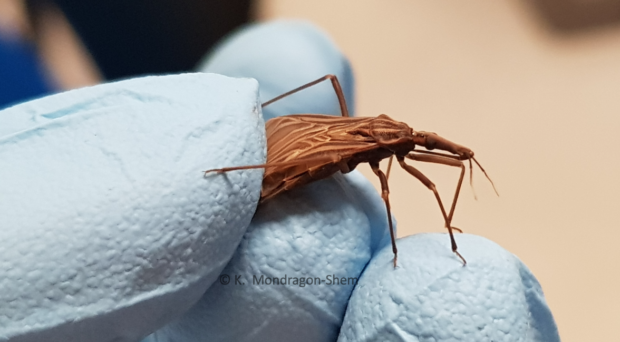
Despite their charming sobriquet, kissing bugs are the vectors of Chagas disease, one of many NTDs re-emerging in Venezuela due to its ongoing healthcare crisis. It is caused by Trypanosoma cruzi parasites and transmitted through the faeces that triatomines leave on the skin after feeding (not so charming). Once a person is bitten, scratching the site can inadvertently introduce parasites into the bite, eyes, or other parts of their body. Signs and symptoms of the disease may show up years after the initial infection, and include severe damage to the heart or gastrointestinal system. Historically, disease control has been based on indoor residual spraying and the improvement of housing conditions in rural areas, but the absence of reliable surveillance has resulted in continued transmission.
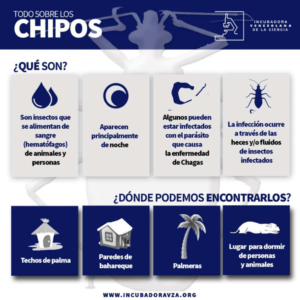
One of the difficulties in controlling Chagas disease is the extensive distribution of its vectors. Rhodnius prolixus, for instance, has both sylvatic and domestic populations, making it widespread and hard to manage. Furthermore, Venezuela hosts over 20 other kissing bug species, with different cycles that maintain transmission in both domestic and in sylvatic habitats. Oral transmission outbreaks, where fruits and juices are contaminated by infected triatomines, are also a concern in many areas.
An alternative solution
A recent paper by Delgado-Noguera and collaborators describes how scientists from the Incubadora Venezolana de la Ciencia rolled out the #TraeTuChipo [#BringYourKissingBug] campaign, a citizen science project using a “digital, user-friendly platform” for the monitoring of triatomines and Chagas disease. To participate in the project, citizen scientists need only a smartphone with camera and access to a social network – allowing those in remote, low-resource communities to contribute. Any triatomines spotted can be reported via surveys, social media, or phone, after which the reporter is contacted by a researcher to provide photographs. Within a day, identification is confirmed, and a public dashboard is updated with the information. Further instructions follow for the submission of the kissing bug to a collection centre (e.g., schools, churches, medical facilities, etc).
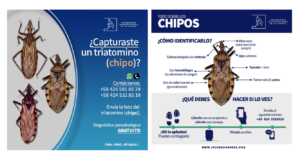
Apart from training citizens in the identification and safe handling of kissing bugs, the campaign wants to create an up-to-date database of triatomine distribution in Venezuela (for both public and healthcare use), and to analyse any specimens physically submitted for T. cruzi infection and blood meal sources.
So far, the project has received 113 bug reports, of which 79 were confirmed as triatomines. The main species reported from domestic areas was Panstrongylus geniculatus, something that caught the attention of the researchers as it has been historically found in peri-domestic and sylvatic environments; the result coincides with increasing findings of P. geniculatus in human dwellings. Together with the low reports of R. prolixus (assumed to be the most common Chagas disease vector in Venezuela), this has scientists taking a closer look at the role each vector might be playing in the transmission of Chagas disease in Venezuela. However, the project is still in early stages, and they hope to gather more data as people continue contributing to it. In their paper, the authors also highlight the importance of continuous communication between researchers and the community: through direct engagement with the public, people learn more about kissing bugs, Chagas disease, and how to protect themselves. It also helps scientists become better communicators, as they figure out the best ways to convey important information to the wide range of audiences targeted by the campaign.
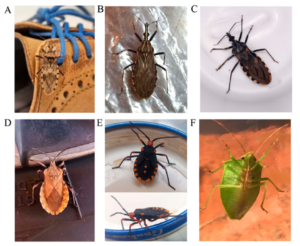
The project is not without it limitations, the researchers admit. For instance, most reports have originated from the larger urban areas where people might be more connected or have greater access to social media. Reports from rural areas would be very valuable to the project.
Embracing citizen science
This is not the first time this approach has been used. In 2015, Curtis-Robles and collaborators published a paper on their citizen science approach for looking at triatomine distribution and Chagas disease risk in Texas; through interactive websites, emails and phone calls, they received 1,980 kissing bugs and recorded their distribution even in areas previously believed to be free of them. A review in 2011 looking at the best ways to keep houses triatomine-free found that insecticide-treatment is highly effective, but community-based monitoring also provided great advantages towards disease control strategies. Citizen science projects are becoming increasingly common for mosquito surveillance: in Spain the ‘Mosquito Alert’ programme provides an early warning system for the invasive Aedes, with similar initiatives in Germany and Australia. In Canada and Belgium similar projects are in place to monitor ticks and their pathogens.
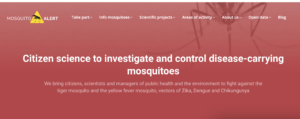
Engagement between communities and researchers can be a powerful tool to provide information about of the vector-borne diseases and their risks. With the #TraeTuChipo campaign, Venezuela’s scientists hope to use tele-entomology (sometimes called e-entomology) to connect with citizens and monitor kissing bugs and Chagas disease in their country.

Comments